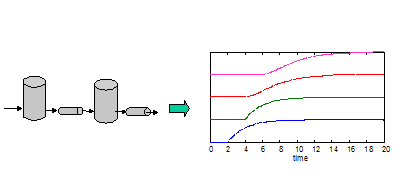

Chapter 5
Dynamic Behavior of Typical Process Systems
Home
Index
Check Your Reading Study Questions Thought Questions
The questions will be categorized according to the the two keys concepts in the chapter.
| Self-Regulation | Structures of Simple Systems |
 |
 |
| Check Your Reading |
Solidify the Concepts |
| 5.1 What determines the order of a dynamic model? |
| 5.2 This second order process, which is two first order systems in series, can never be underdamped. |
| 5.3 Complete this statement: Self-regulation is... |
Self-Regulation |
| 5.4 Processes are often connected in series. Non-interacting first order systems in series have the following property. |
Structures of simple systems |
| 5.5 A quick way to estimate the overall dynamic model of a series of first order systems, is as a first order system with the following equations. |
Structures of simple systems |
| 5.6 Apparent dead time can result from... |
Structures of simple systems |
| 5.7 Parallel systems can result in unique dynamic responses when... |
Structures of simple systems |
| By unique, we mean that the
output variable might not be reasonably approximated with a dead
time-first order curve. An example is an inverse response.
|
| 5.8 A dynamic system with recycle... |
Structures of simple systems |
| 5.9 In the distillation model, the equation for liquid flow rate leaving the tray is valid for all values of the liquid level. |
Structures of simple systems |